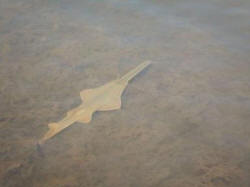|
 Scientists
document Florida 'virgin births' of endangered sawfish Scientists
document Florida 'virgin births' of endangered sawfish
 Send a link to a friend
Send a link to a friend
[June 02, 2015]
By Will Dunham
WASHINGTON (Reuters) - Scientists have
documented in Florida a series of "virgin births," reproduction without
mating, in a critically endangered sawfish species pushed to the brink
of extinction by over-fishing and habitat destruction.
|
|
 The scientists said on Monday it marks the first time the
phenomenon called parthenogenesis has been seen in a vertebrate in
the wild. Some females may be resorting to asexual reproduction
because smalltooth sawfish numbers are so low mating opportunities
may not exist, they said. The scientists said on Monday it marks the first time the
phenomenon called parthenogenesis has been seen in a vertebrate in
the wild. Some females may be resorting to asexual reproduction
because smalltooth sawfish numbers are so low mating opportunities
may not exist, they said.
"There have been a number of cases in reptiles, birds and sharks of
'virgin birth' in captivity," Stony Brook University marine
biologist Andrew Fields said. "This raises many questions about how
common this mode of reproduction is in the wild."
In parthenogenesis, a female's egg cell can develop into a baby
without being fertilized by a male's sperm cell.
In making an egg cell, a precursor cell divides into four cells. The
one that eventually becomes the egg cell retains key cellular
structures and the gel-like cytoplasm. The other three hold extra
genetic material.

In parthenogenesis, one of those cells essentially acts as a sperm
cell and fuses with the egg. This "fertilized" egg possesses about
half the mother's genetic diversity, a trait allowing
parthenogenesis to be detected through genetic testing.
Smalltooth sawfish are born and live for about three years in
southwest Florida estuaries before moving into ocean coastal
habitats.
The researchers were investigating sawfish inbreeding when they
discovered seven, all healthy, born via parthenogenesis, about 3
percent of those examined.
"It really surprised us," said Kevin Feldheim, manager of the
Pritzker Laboratory for Molecular Systematics and Evolution at
Chicago's Field Museum. "It is possible that numbers are so low that
females have a hard time finding mates. In such a situation,
parthenogenesis can be used as a last-ditch effort for a female to
pass on her genes."
[to top of second column] |

Florida Fish and Wildlife Conservation Commission fish biologist
Gregg Poulakis said the sawfish came from the Peace and
Caloosahatchee rivers, which feed the Charlotte Harbor estuary
system.
Sawfish, a type of ray, have a flattened shark-shaped body and a
long, flat snout with pairs of teeth on the side used to find, stun
and kill prey. They grow up to 18 feet (5.5 meters) long.
Their population collapse follows habitat loss and "unintentional"
over-fishing, being caught in nets targeting other species. They
received U.S. federal endangered species protection in 2003.
The research appears in the journal Current Biology.
(Editing by Eric Walsh)
[© 2015 Thomson Reuters. All rights
reserved.]
Copyright 2015 Reuters. All rights reserved. This material may not be published,
broadcast, rewritten or redistributed.

 |